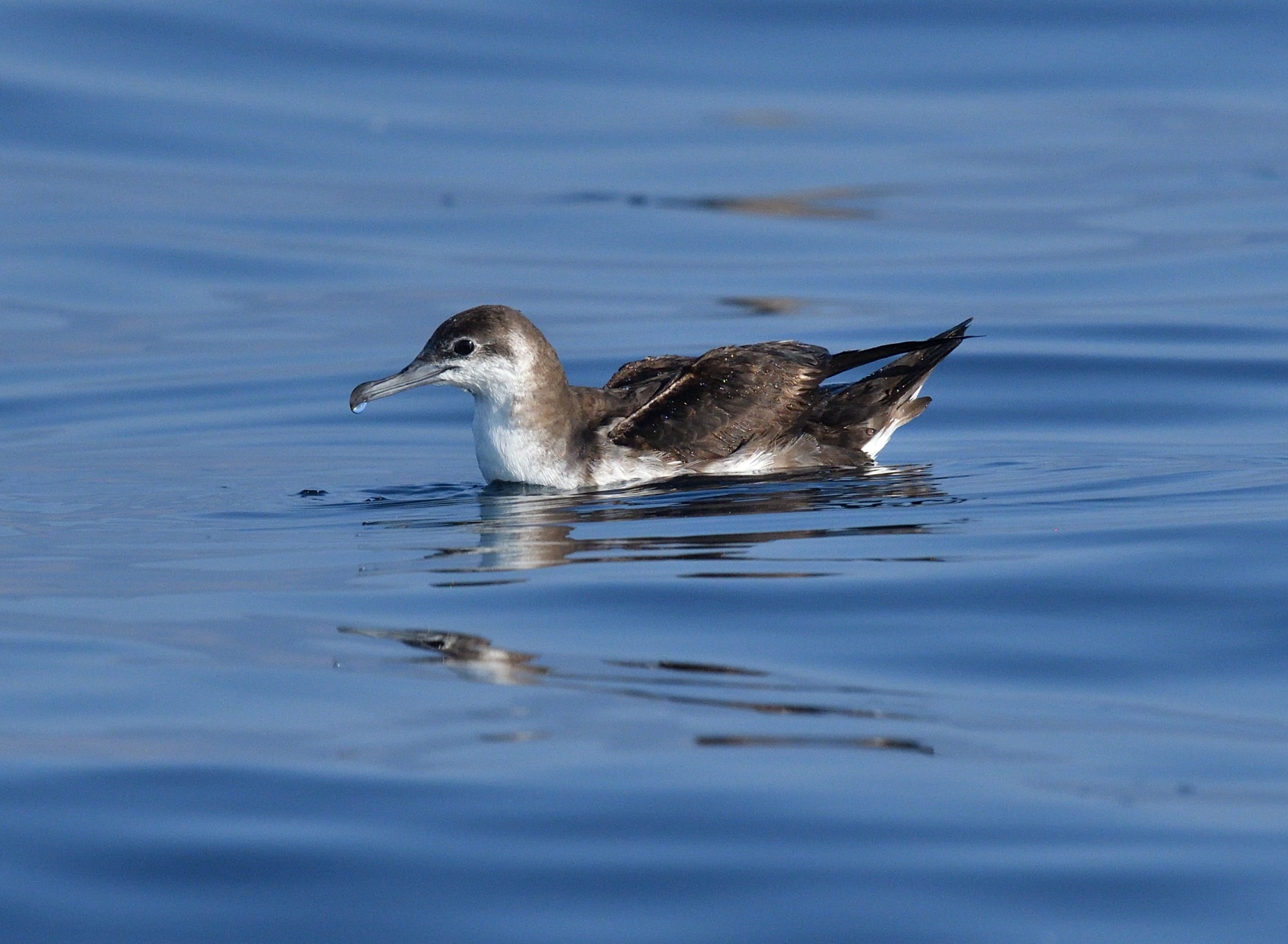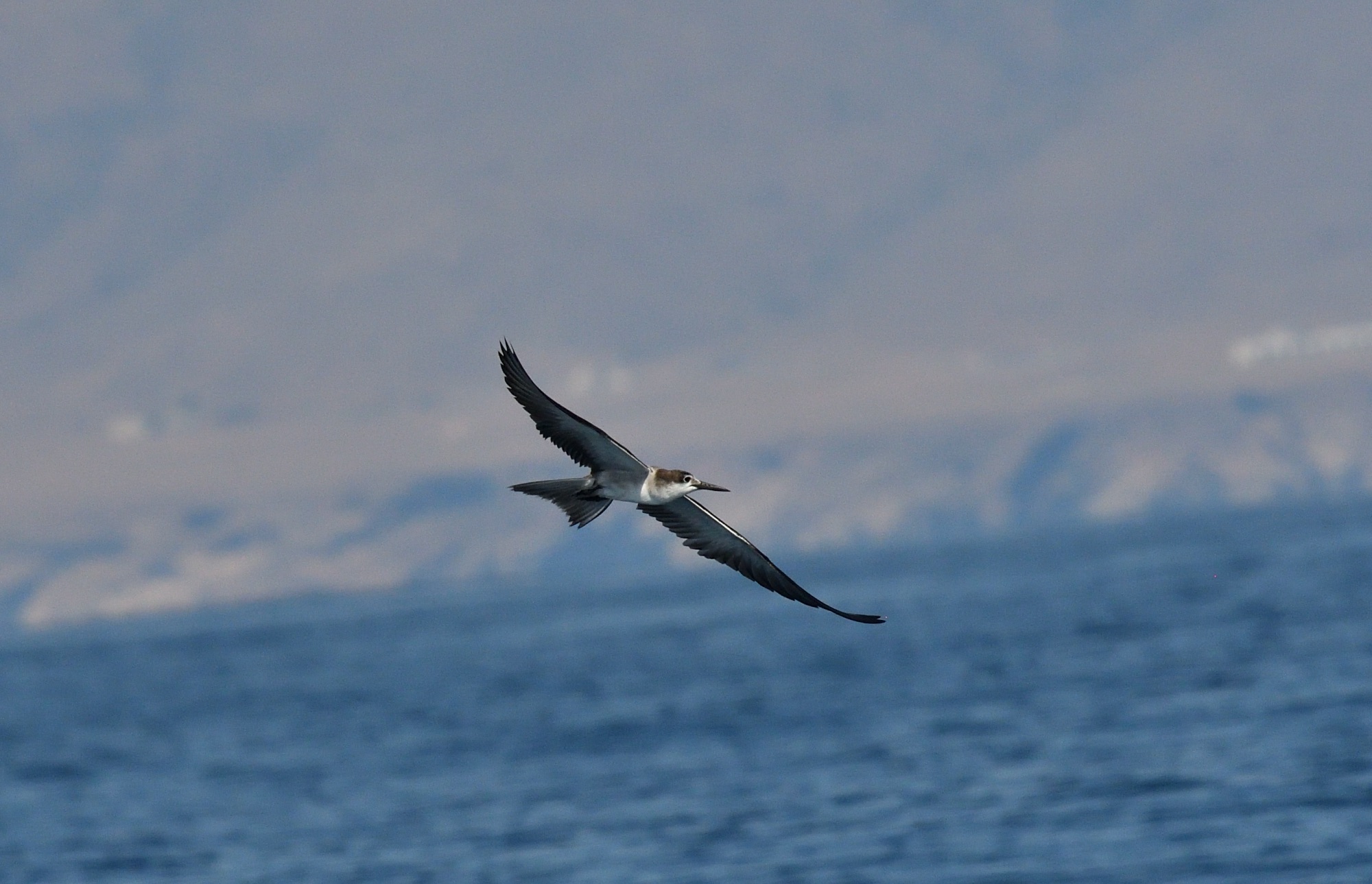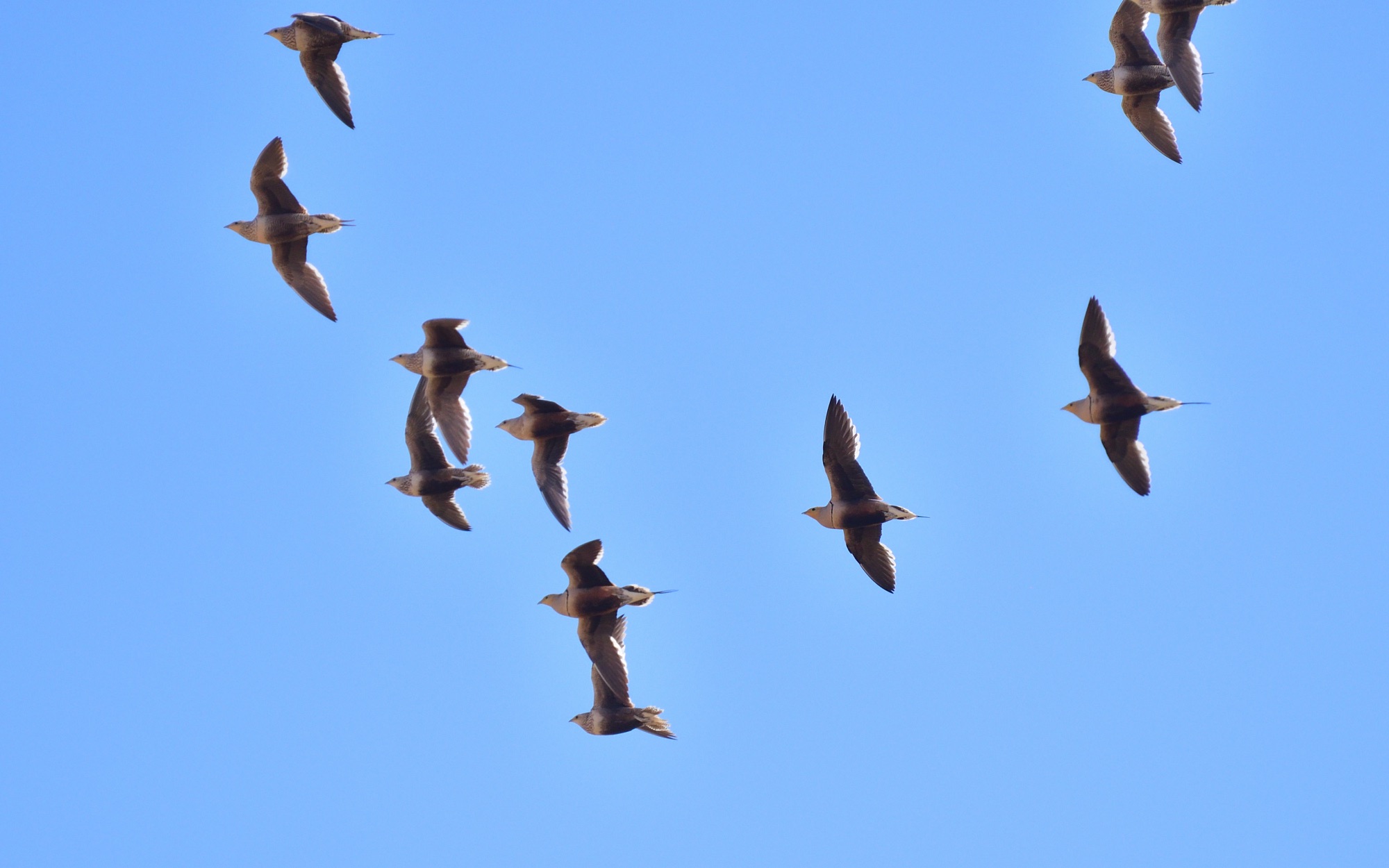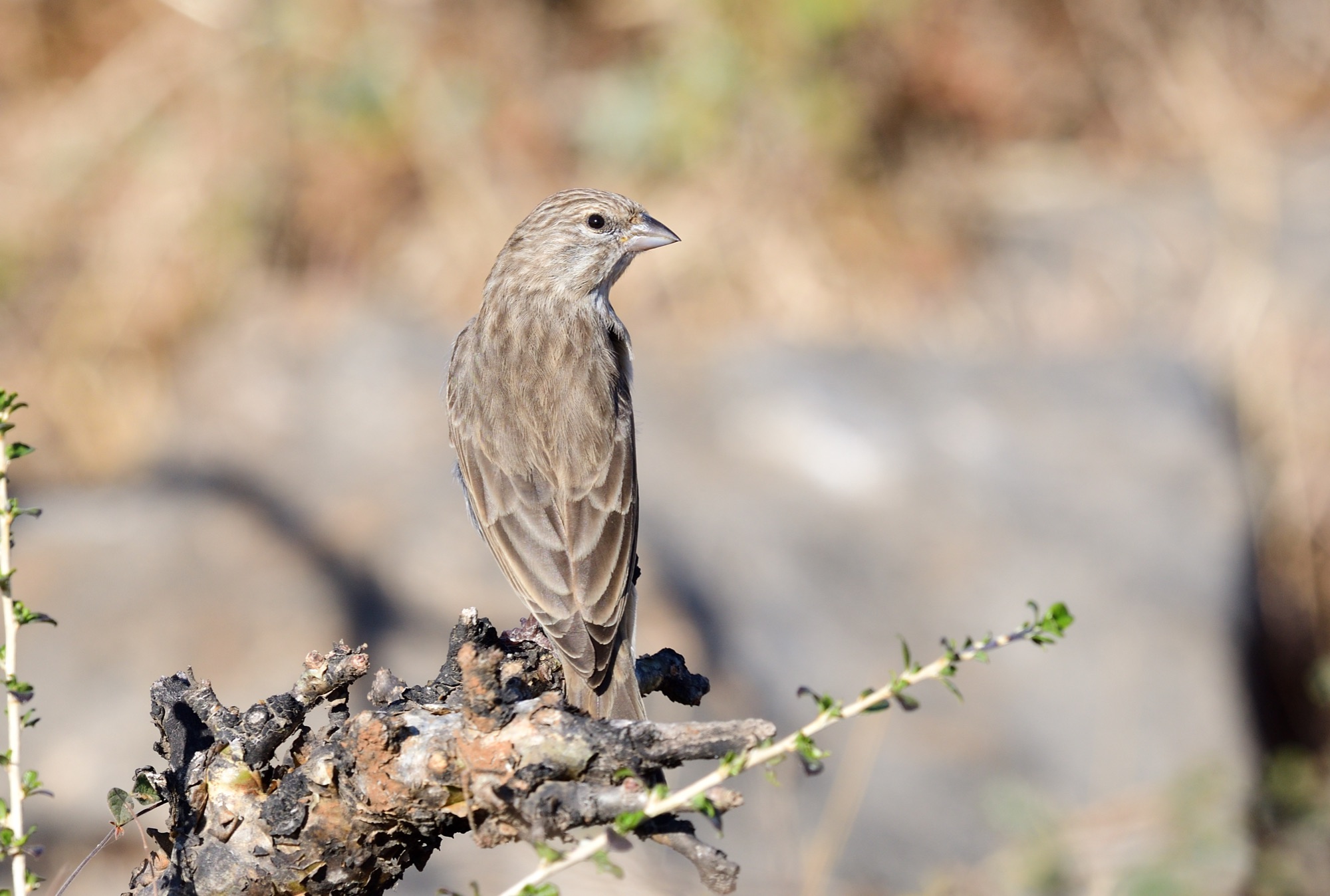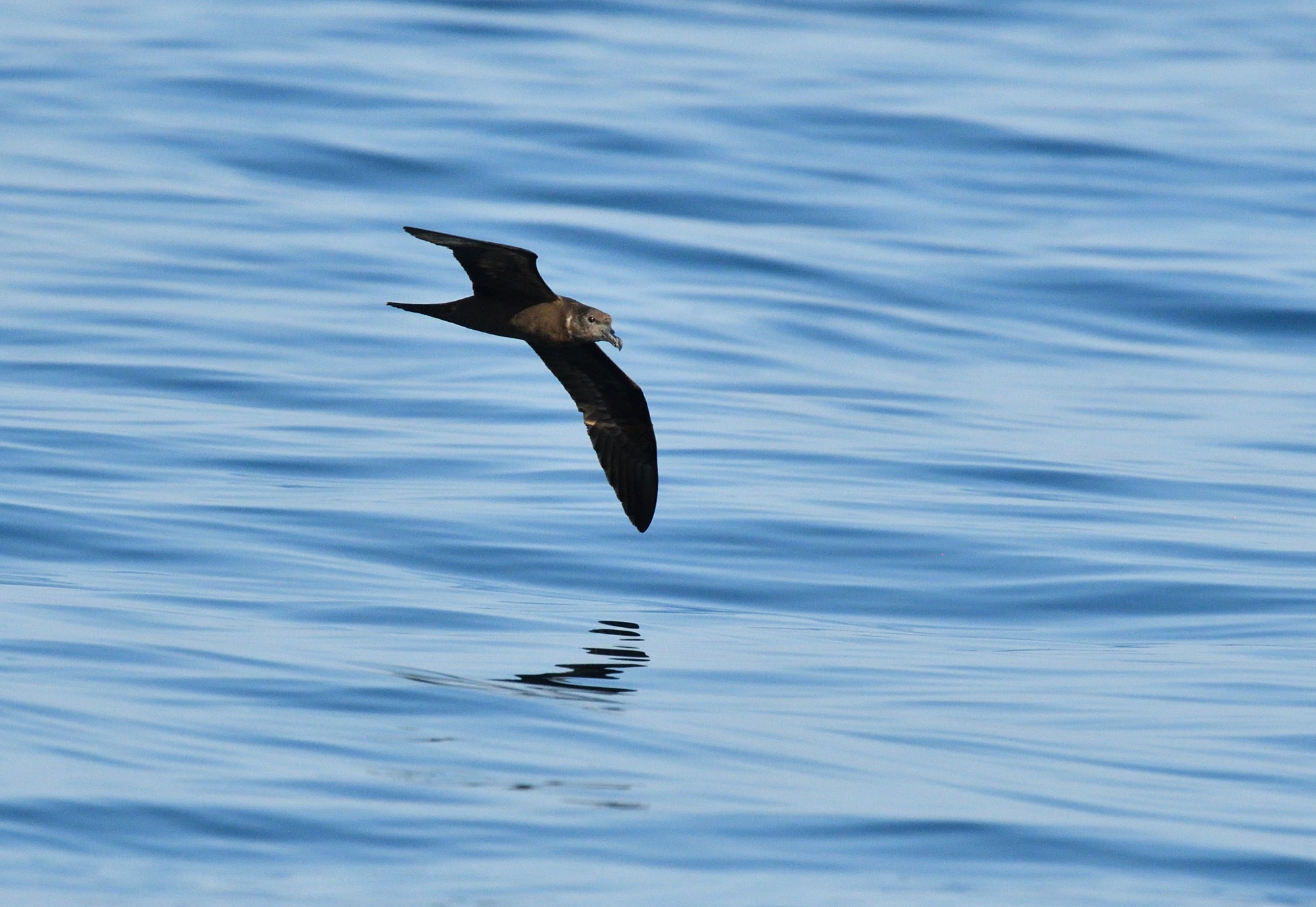OMAN TOUR REPORT 5th Nov - 16th Nov 2022
Day 1 MUSCAT - SAYQ PLATEAU
Collecting the group for my 4th Oman tour in a year from Muscat airport we drove to the hotel I’d been staying at for the previous 2 nights as there’s a nice lagoon in the wadi below. I was particularly pleased to catch up with some ‘dross’ that we don’t usually see elsewhere such as Red-vented and White-cheeked Bulbuls and a Bank Myna as well. A pair of Delicate Prinias (a recent split from Graceful Prinia) were seen well, along with Arabian Green Bee-eater, a few Indian Silverbills were seen, several White-spectacled Bulbuls, a pair of Western Marsh Harriers, Red-wattled Lapwing, Whiskered Tern, Great Cormorant, Squacco Heron, Shoveler, Purple Sunbird and some Pale Crag Martins. Leaving here we drove to Al Ansab Lagoons only to find there was too much building work taking place to warrant a stop so we decided to head north along the fast expressway to the coast. Here we took a boat out and sailed around the islands of xxxxx looking for a lingering Sooty Falcon – but we were a couple of days too late and the last lingerers had flown south towards their wintering home of Madagascar. The highlight here were the most exceptional views of Socotra Cormorants perched on the rocks and this was undoubtedly the closest and best views I’ve ever had of this range-restricted species. Other birds seen included 3 Western Reef Herons, 7 Pallid Swifts, Peregrine Falcon and an Osprey. After we’d waded to shore as the tide was right out, Lynzi had prepared a fine picnic lunch for us, which was greatly appreciated by all. Scoping the roosting gull and tern flock revealed both Lesser Crested and Great Crested Terns, a single Sandwich Tern and both Heuglin’s and Steppe Gulls, along with numerous Slender-billed and Sooty Gulls. Amongst the numerous Lesser Sandploverswere several Greater Sandplovers, Grey Plover, Eurasian Curlew, Kentish Plover, Common Redshank and Common Greenshank. And we eventually reached our hotel at 2.15pm where we enjoyed a hot shower and siesta before the first owling session of the tour. We headed to our favourite wadi where we heard Lilith’s Owl, spotlit a Pallid Scops Owl about 100 feet above us on a cliff face (yeah go figure!) and unbelievably heard a female Omani Owl call repeatedly, but it was so high up and too distant to be visible!
Day 2 COAST NORTH OF BARKA - NAKHL
Headed towards Nakhl and drove into an amazingly steep-sided wadi. We began with a nice little walk along an acacia-lined gulley that produced our first Plain Leaf-Warbler, as well as a gang of 3 Arabian Babblers, lots of Purple Sunbirds and a Central Asian Lesser Whitehtroat (halimodendri race). Returning to our SUV’s we hadn’t driven more than 200m when a Red-tailed (Persian) Wheatear appeared and gave superb views through the scope, before flying right past us and posing on a close bush. Our picnic breakfast was taken a short way further along the dirt track and was accompanied by a Hume’s Wheatear, Daurian (Isabelline) Shrike, a few Desert Larks and a brief Streaked Scrub Warbler. We enjoyed further views of both wheatears as we entered the main section of the wadi where at least 2 Menetries’s Warblers appeared, with one in particular giving great views, and eventually cracking looks at a pair of Streaked Scrub Warblers.
Leaving here we returned to the hotel for lunch and a rest before heading 30 minutes up the coast to a nice viewpoint where we spent the next hour scanning some mudflats at low tide. What a great time was had by all with 5 Terek Sandpipers, 3 Pacific Golden Plovers, 2 Temminck’s and 4 Little Stints, many Lesser Sandplovers and a few Greater Sandplovers, plenty of commoner shorebirds, 2 Eurasian Spoonbills, several Western Reef Herons and others. I think we all enjoyed the sight of several Pale Crag Martins cruising past us at eye level just a few metres away. Leaving here we drove back to our favourite wadi where we heard Omani Owl last night, but alas it was pretty quiet tonight. We did get rear end views of Pallid Scops Owl and a perched Little Owl (Lillith’s) to round off a super day.
Day 3 WADI MUAYDIN - JABAL AL AKHDAR
Left hotel at 6.30am and headed inland towards Nizwa, calling in to a random wadi where we enjoyed another of Lynzi’s fine picnic breakfasts, tea & coffee etc. We had excellent views of a Plain Leaf Warbler perched in a bare tree and singing away – possibly the best views I’ve ever had of this diminuitive species. Another Menetries’s Warbler was found, and we finally had our first Striolated Bunting, along with Indian Rollers, Lesser Whitethroats, and a few eastern Black Redstarts. Tim spotted a Blackstart perched on a rock across the wadi and on the drive out we saw a small group of Grey Francolins. Leaving here we headed towards Jabal Al Akhdar, calling in to Wadi Muaydin where a spot of raptor watching produced a flyover Lappet-faced Vulture and 5 distant Egyptian Vultures. After a protracted lunch in the nearby village we headed up to the dizzy heights of Jabal Al Akhdar where we had a few hours to rest before meeting for dinner and then another owling session. But just before dinner a few of the guys ventured into the gardens and scored big time with a Black-throated Thrush and Common Rock-Thrush. Needless to say the owling session went as per usual – nada!
Day 4 SAYQ PLATEAU - NIZWA
Everyone met at 7am for the short 15 minute drive to our birding spot. This can be a great place to find a rarity but this morning it was pretty quiet, apart from many eastern Black Redstarts, a few Lesser Whitethroats and the ubiquitous White-spectacled Bulbuls. So we decided to head back early to the hotel for breakfast, but hadn’t gone more than a few hundred metres when an Arabian Babbler flew across the road in front of us. Stopping to have a look, we discovered there were 3 birds and we enjoyed pretty decent views of them, along with a couple of Common Whitethroats.
After breakfast, we checked out the gardens and surrounding area of our hotel and had our closest views of Hume’s wheatear so far, but best of all were the pair of Lappet-faced Vultures circling more or less right above us. So we then loaded the luggage onto our SUV’s and drove up further onto the Sayq Plateau, exploring the juniper forest and hoping for a sighting of the endemic race of Common Woodpigeon. Well, we didn’t find one of them but instead had another Common Rock-Thrush perched on roadside telegraph wires. As we watched this another Central Asian Lesser Whitethroat (halimodendri) was seen, before we ‘off-roaded’ across the plateau. This turned out to be very productive with another 2 Common Rock-Thrushes, the first of 5 Pied Wheatears on a rocky hillside and an amazingly close encounter with a Long-billed Pipit. Further on we found more Pied Wheatears, a Desert Wheatear, and amongst the numerous eastern Black Redstarts, at least 3 stunning Ehrenberg’s Redstarts(samamisicus race of Common Redstart).
Leaving here around 3pm we drove to our next hotel through ridiculously narrow streets beside the souk in Nizwa for an unexpectedly cultural evening!
Day 5 NIZWA - BARR AL HICKMAN
Well, we left after a late breakfast and drove for 4 hours down to Mahut, which is located quite close to the wader mecca of Barr Al Hickman. On the drive south we picked up a few Egyptian Vultures, Steppe Eagle, Greater Hoopoe Lark and several fine Black-crowned Sparrow-Larks. The Hoopoe Lark gave outstanding views as it fed beside the road and even sang for a short while….
Upon arrival at Mahut we headed down to Filim only to find the tide was as far out as it could possibly be, with mega distant scope views of a few Crab-Plovers that left a rather sour taste in the mouths of everyone. But there were still many, many thousands of shorebirds to scan through and we picked up a Broad-billed Sandpiper feeding quite close, a Spotted Redshank, 3 Terek Sandpipers, as well as many commoner shorebirds we are all familiar with in the UK.
Day 6 BARR AL HICKMAN
What an amazing morning at the wader mecca of Barr Al Hickman as we went to a new site involving a drive across the desert on a rather ambiguous track. Arriving at sunrise we set up scopes and found the mudflats covered in a carpet of shorebirds as far as the eye could see. It was incredible and to put numbers to each species is impossible. There could have literally been thousands of Dunlins, Little Stints and Lesser Sand Plovers, with smaller numbers of Greater Sand Plovers, many hundreds of Common Redshank and Bar-tailed Godwit. As we worked our way along the beach we found at least 67 Crab-Plovers, but still a little distant for our liking so we continued walking with the tide slowly rising and pushing birds closer. Returning to our vehicles for breakfast we discovered that the Crab-Plovers had disappeared, so we drove along another dodgy track looking for them. Sure enough we found their roost site and had the most incredible time, logging over 450 Crab-Plovers at their roost. Amazingly we also found 5 Great Knot tucked in with a big gathering of Bar-tailed Godwits. As we scoped these birds there was a constant procession of flocks of shorebirds, with more Terek Sandpipers mixed in with large flocks of Common Redshanks. We spent a long time wader watching, as well as exploring the coastal scrub next to the beach where a Red-breasted Flycatcher was the best find.
Well, we eventually left here and returned to our hotel for a late lunch and a little rest before heading to a nearby park and look for the reported Asian Koel. We scored with this scarce bird relatively quickly and then found ourselves invited I to the home of the person who owned the park. We were given coffee and sweets and were invited to a barbecue in a nearby wadi with some Bedouins this evening, which we duly did. What a great treat this was to be out in the desert under a picture-perfect starlit sky, seated on rugs amidst the sand dunes and fed some delightful food. Many group photos were taken and we were even gifted their turbans! The Omani people are truly amongst the friendliest I have ever met. What a day!
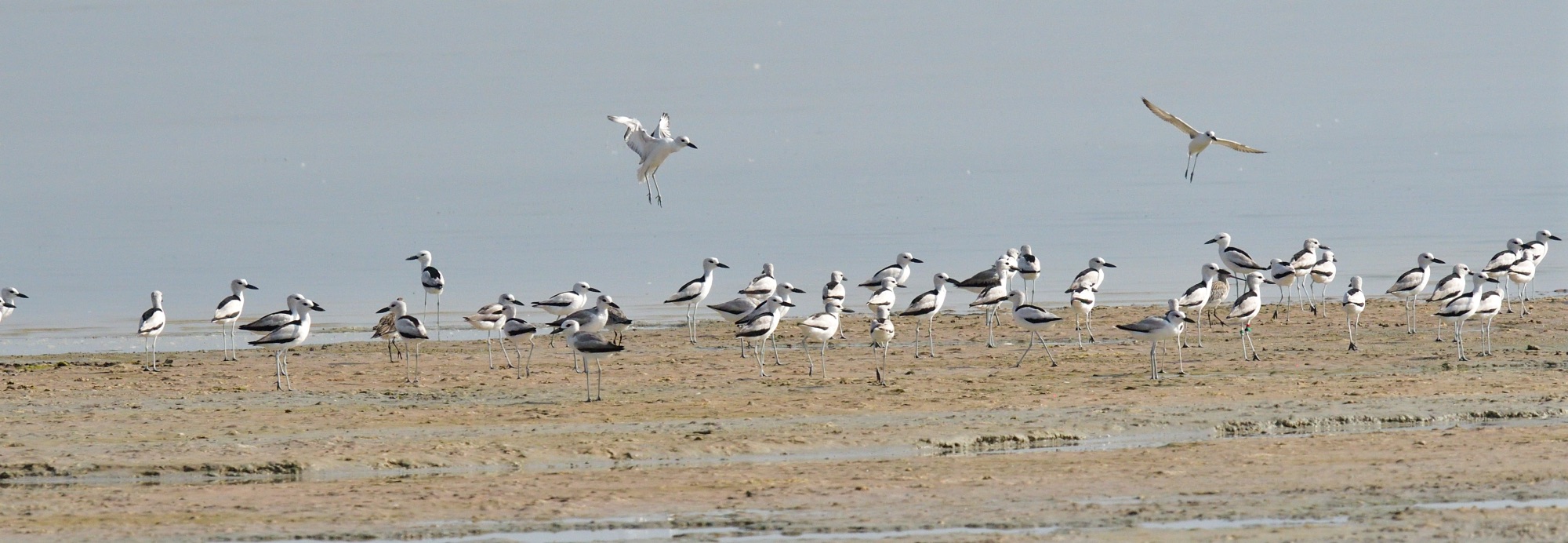
Day 7 MAHUT - HAIMA
This was basically a travelling day as we drove from Mahut to Haima. We’d normally stay at the terrible Qatbit Motel but we got bumped out and had to rearrange tonight’s accommodation! Getting bumped out of the worst hotel you’ll find on most bird trips is not funny tbh. Anyway, we checked out Mahut sewage pools which was pretty quiet and then set out on the 4 hour drive, stopping along the way for a field breakfast and then to find Asian Desert Warbler, along with our first Isabelline Wheatears, many Desert Wheatears and Brown-necked Ravens. Haima sewage pools were quiet so we checked into a decent hotel before going on down to Al Ghaftain Resthouse. Here a Red-breasted Flycatcher and 14 Blue-cheeked Bee-eaters were the pick of the bunch, with a supporting cast of 3 Black and 3 Common Redstarts, and a few Common Chiffchaffs. Dinner tonight was brilliant and we were in bed early, in readiness for a crazy early start tomorrow.
Day 8 MUNTESAR OASIS - AL BEED FARM - SHISR FIELDS
What a day this was! Left at 3am and went to Muntesar Oasis, which is a little tricky to find in the dark but we arrived about an hour before sunrise. Our main target was Egyptian Nightjar and after a little wait I managed to call one in, which flew right in front of us. Result! So we waited for sunrise and then began exploring the area thoroughly. There’s always something different here and it’s a site I thoroughly enjoy visiting but at first activity seemed a little slow with only a Daurian Shrike of note. But with a little patience and perseverance we also found Temminck’s Stint, Dunlin & Little Stint (we are out in the desert you know), as well as Common Snipe and Wood Sandpiper. I always get a kick out of seeing stuff like this out of context. Paul had brief views of Eurasian Reed Warbler, and we all had nice looks at a Bluethroat drinking at a puddle, a few Tree Pipits flew in to the oasis, a Red-breasted Flycatcher was seen, but our best find was undoubtedly a Siberian Stonechat.
We left here and drove for an hour down to the Qitbit Hotel to check out their leafy gardens for migrants. As luck would have it we lucked in on a Hume’s Whitethroat (4th for Oman), and it was a real hulk a warbler with pale eyes and hefty bill. A Steppe Buzzard was also an unusual sighting here, and we also saw Siberian Chiffchaff and yet another Red-breasted Flycatcher.
Before leaving here we topped up on cold drinks and ice-creams from the gas station before driving around an hour to another of my favourite spots at Al Beed Farm. We usually spend most of the afternoon into early evening here but at the back of my mind I wanted to fit in a visit to another set of farms that had been producing some really good rare birds lately. So once we turned off the main highway and hit the dirt road we began birding. Several flocks of Spotted Sandgrouse flew over giving their distinctive calls, a few Namaqua Doves were around, a Short-toed Eagle flew low overhead, and this was followed by a little raptor-fest with Greater Spotted Eagle, Steppe Eagle and a cracking Eastern Imperial Eagle. We also had Eurasian Sparrowhawk, Western Marsh & Pallid Harriers, our first European Rollers, Arabian Green & Blue-cheeked Bee-eaters, Arabian Grey Shrike(aucheri race), and several Black-crowned Sparrow-Larks.
So on we raced to Shisr Fields, another 90 minutes away and what a fantastic site this is. Lush green fields interspersed with ploughed fields and surrounded by desert. Driving down into the valley we could see a number of White Storks feeding in one of the alfalfa fields next to the road, and as we stopped to have a look what else was around, a flock of Rosy Starlings flew by. As we set our scopes up to scan, a Common Cuckoo was spotted perched on a sprinkler out in the field and a few Cattle Egrets flew in. And then I noticed a small group of birds with distinctive wing patterns flying behind us over a ploughed field. Yes! It was the 6 Sociable Lapwings that had been present for some weeks, but they kept on going and going before dropping into a distant field. So we sped off after them and relocated them at some distance but looked great in the scope. This was a huge lifer for some and high fives all round! So with that huge result we were all buzzing and we still had a good hour of daylight left, so decided to have a drive around and explore a bit as Wattled Starling and Red Collared-Dove had been seen here recently. We didn’t find either of those rarities but did come across a flock of over 100 Rosy Starlings on telegraph wires and in the surrounding fields to round off a very exciting day’s birding. All that remained was to drive to Thumrayt and our next hotel.
Day 9 MUDDAY - AYN RAZAT - AYN HAMRAN
A 5.30am departure seemed quite reasonable after yesterday’s lunacy and we arrived just after sunrise at the Hypocolius hotspot of Mudday. A Hooded Wheatear perched on the rocks above us was the first bird of the day before we drove to another area to look for Hypocolius which proved worthwhile as we had a male perched in a palm tree before it flew on to telegraph wires closer to us. It remained for a minute or two before flying back into cover and just at that moment I could hear some sandgrouse flying over. That prompted a high-speed departure to their drinking pool where we were treated to an amazing display as many hundreds of Chestnut-bellied Sandgrouse flew around before alighting in small groups to drink. We were lucky to have over 40 Crowned Sandgrouse fly in, again in groups of 3 -6 and some of them sank their bellies into the water before departing. There was also an Osprey here, which seemed totally out of place in this desert environment. It was a magical experience watching these sandgrouse and a definite tour highlight, so once the activity died down we drove back to the village and found Nile Valley Sunbird, Blackstart, Eurasian Hobby, and a pair of Abyssinian White-eyes.
We left here and headed back to the hotel, picked our luggage up and drove to Salalah where we called in to Ayn Razat for a picnic lunch and to see the day roosting pair of Arabian Eagle Owls. What a sighting this was and a really cracking bird. Also here was Arabian Sunbird, many Abyssinian White-eyes, and an African Paradise-Flycatcher. We then left here and drove to our superb hotel to check-in before driving over to Ayn Hamran, seeing a Crested Honey-Buzzard in the middle of the town. Ayn Hamran is a fantastic birding site and there’s always something interesting here and this afternoon proved to be damn good, with a huge mixed flock of swifts overhead that comprised of Alpine Swift, Pallid Swift and quite a few Forbes-Watson’s Swifts. I must admit the Eastern Nightingale had me stumped as it skulked in the gloom of dusk beneath a large bush, but we also had Spotted Flycatcher, European Roller and stacks of Blue-cheeked Bee-eaters. Our patience at dusk was rewarded with outstanding views of a superb Arabian Scops-Owl perched overhead.
Day 10 AYN TOBRUQ - EAST KHAWR - AYN HAMRAN - KHAWR RAYSUT.
Headed to the traditional stake-out of Ayn Tobruq for Arabian Grosbeak this morning, but for the first time ever on my tours it didn’t appear this morning. I’d heard this species had been elusive so far this season but it was still a huge disappointment I can tell you. We did see an Eastern Imperial Eagle on a carcass on the drive in, Black-crowned Tchagra and an Arabian Sunbird but the area was generally quiet this morning. So we headed back to the hotel for breakfast, after which we popped over to my usual site for Spotted Thick-knee, which showed very well. Next up was the inland lagoon of East Khawr and what a place this is, with a flock of Glossy Ibis, Red-knobbed Coots, White-winged and Little Terns and best of all, a Small Pratincole picked up by Jo. So we left here and returned to Ayn Hamran, parking in the shade of some large trees for our picnic lunch. A walk along the watercourse gave us further views of Abyssinian White-eyes, African Paradise-Flycatcher, Tristram’s Starlings, and best of all an Upcher’s Warbler.
Khawr Raysut was next up where in the late afternoon we notched up a fine selection of species including 10 Eurasian Spoonbills, a couple of White-winged, 33 Caspian, 14 Gull-billed, several Lesser Crested, and many Greater Crested Terns. A Red-necked Phalarope patrolling the mudflats looked rather out of place amongst a nice selection of commoner shorebirds, plus we also saw Caspian, Heuglin’s, Steppe and Slender-billed Gulls. You gotta love this place!
Day 11 WADI KHEESH - RAYSUT SEWAGE POOLS - KHAWR MUGHSAYL - WADI MUGHSAYL
After breakfast at the hotel we drove to the site of the last known Arabian Grosbeak sighting from a few days ago, at Wadi Kheesh. The drive to this spot can only be described as interesting! The road is a bit like a rollercoaster and can leave the passengers in your car feeling a little queezy! Apparently the grosbeak has been coming to a drinking trough, so we staked it out for several hours and enjoyed a constant procession of birds visiting the spot such as numeous Laughing Doves, African Paradise Flycatcher, many Ruppell’s Weaver, African Silverbills and loads of Cinnamon-breasted Buntings, with a pair of Arabian Warblers and an Arabian Sunbird nearby. In the hills above us we saw Eastern Imperial Eagle, Short-toed Eagle, a pair of Bonelli’s Eagles and an Eurasian Sparrowhawk.
We left here rather disappointed at the lack of grosbeaks and zoomed over to Raysut Sewage Works, which never disappoints and we enjoyed good close looks at Abdim’s Storks amongst the hordes of White Storks. There are at least 3 tanks full of water where we saw good numbers of Garganey amongst the Northern Shovelers and Eurasian Teals. Also present were Spur-wingedand Red-wattled Lapwings, Common Ringed Plover, Temminck’s & Little Stints, Green, Marsh & Wood Sandpipers, and best of all an African Sacred Ibis.
From here it’s only around a 45 minute drive to get further south along the coast to Mughsayl beach, where our picnic lunch at the beach was superb as always and was enlivened by some success at seawatching with 5 Persian Shearwaters, a Brown Booby, 100’s of Red-necked Phalaropes passing by, Caspian, Whiskered & Greater Crested Terns, whilst an Arctic Skua was something of a surprise. A large flock of Socotra Cormorants were fishing just offshore and gave great scope views, and at least 2 Eurasian Hobbies were hunting in the hills behind the beach and a Tawny Pipit was seen beside the road. A quick check of Khawr Mughsayl presented us with the usual species already seen so far such as Greater Flamingo’s, Red-knobbed Coot, Glossy Ibis, Eurasian Spoonbill, Squacco Heron, Intermediate Egret and Osprey amongst others.
As it was getting towards late afternoon it was the perfect time to head into Wadi Mughsayl, which was excellent as always. The rocky track into the wadi gave us superb views of a group of Arabian Partridges, as well as a single Sand Partridge (but one is all you need right?), several Arabian Wheatears, Desert Lark and Pale Crag-Martin. Once it was dark we had the quickest ever owling session I’ve known here, as we scored blisteringly cracking views of a close Desert Owl within 3 minutes of beginning. Wow!
Day 12 AYN HAMRAN - AYN TOBRUQ - WADI KHEESH - JABAL SAMHAN - TAWI ATAYR - KHAWR RAWRI
This was our last full day of the tour, as tomorrow we’d be out on a pelagic for most of the morning. So this was our last shot at the grosbeak. I decided we’d check out every grosbeak site, which was a tough ask but we had to give it a go. So we tried Ayn Hamran, Ayn Tobruq and surrounding area and Wadi Kheesh all before 10.30am and still didn’t get one. In fact nobody has been seeing it this week! So we headed east along the coastal highway and turned inland to visit Tawi Atayr where we looked for Yemen Serin without any joy so didn’t linger and headed up to Jabal Haman for Verrraux’s Eagle, which only two of my group saw! So we returned to Tawi Atayr and nailed Yemen Serin quite quickly, with a group of around a dozen birds feeding with some weavers.
But this isn’t the whole story and we had a number of great sightings today , especially close eagles with up to 6 Eastern Imperial-Eagles in various plumages, several close Short-toed Eagles, Steppe Eagles, and several Greater Spotted Eagles all showing really well. There was also 4 Bruce’s Green-Pigeons, Palestine and Arabian Sunbirds, Eurasian Hoopoe, European Roller, numerous Blue-cheeked Bee-eaters, a few Black-crowned Tchagras, Blackstart, and more.
We ended this evening at Khawr Rawri with a splendid Pheasant-tailed Jacana, along with 20+ Citrine and 40+ Western Yellow Wagtails amongst the rocks, a Black Stork flew over at dusk and is a really scarce sighting in Dhofar, both Turkestan and Isabelline Shrikes, 47 Rosy Starlings in a bare tree and a low-flying Forbes-Watson’s Swift.
Day 13 MIRBAT PELAGIC - WADI DARBAT - EAST KHAWR - SALALAH NATURE RESERVE - KHAWR RAYSUT
Had a really great pelagic out of Mirbat with over 30 each of Persian Shearwater and Jouanin’s Petrel, with some incredible close-ups of the former sitting on the water. A Flesh-footed Shearwater was also equally obliging and sitting on the water amidst our chumming session. Many 100’s of Red-necked Phalaropes were seen, and over 15 Bridled Terns put on a good show, with a close Masked Booby also very well received by my group.
We returned to shore around 11.30am and paid a quick visit to Wadi Darbat for lunch but couldn’t locate the reported Cotton Pygmy-Goose. We then visited East Khawr one last time and enjoyed scanning through the numerous birds but couldn’t find anything new, so we then headed over to Salalah Nature Reserve where the reported Buff-breasted Sandpiper (2nd for Oman) from the USA was found and we also had a Singing Bushlark. Over at Khawr Raysut, all the usual suspects were seen but a fuscusLesser Black-backed Gull was new, and we had a nice look at another Broad-billed Sandpiper and 4 Terek Sandpipers as well amongst the hordes of other shorebirds. And that was the end of another successful Oman tour.
Click on this text to start editing, and enter your own text with some basic formatting. To create a link to another page or website within this section, select the text you want to make into a link and click on the Link icon on the formatting toolbar. Click anywhere outside the text box when you're done to continue working on the rest of your page.
To change the appearance of a block, such as the way in which it is laid out and the width of its columns, click on the Change Layout button on the block toolbar, to the right of each block. You can show and hide many of the elements that make up a block by clicking Block Settings on the right hand toolbar and going to the Elements tab. In Block Settings you can also change other aspects of how a block looks, including margins, colours, animations and background images.
You can change the order that blocks appear on your page using the up and down arrow buttons on the right hand toolbar, or you can drag the entire block using your mouse.
SPECIES LIST:
ANSERIFORMES: Anatidae
Garganey Spatula querquedula
Northern Shoveler Spatula clypeata
Northern Pintail Anas acuta
Eurasian Teal Anas crecca
Common Pochard Aythya ferina
GALLIFORMES: Phasianidae
Grey Francolin Ortygornis pondicerianus
Sand Partridge Ammoperdix heyi
Arabian Partridge Alectoris melanocephala
CAPRIMULGIFORMES: Caprimulgidae
Egyptian Nightjar Caprimulgus aegyptius
APODIFORMES: Apodidae
Alpine Swift Tachymarptis melba
Common Swift Apus apus
Pallid Swift Apus pallidus
Forbes-Watson's Swift Apus berliozi
CUCULIFORMES: Cuculidae
Asian Koel Eudynamys scolopaceus
Common Cuckoo Cuculus canorus
PTEROCLIFORMES: Pteroclidae
Chestnut-bellied Sandgrouse Pterocles exustus
Spotted Sandgrouse Pterocles senegallus
Crowned Sandgrouse Pterocles coronatus
COLUMBIFORMES: Columbidae
Rock Dove Columba livia
Eurasian Collared Dove Streptopelia decaocto
Laughing Dove Spilopelia senegalensis
Namaqua Dove Oena capensis
Bruce's Green Pigeon Treron waalia
GRUIFORMES: Rallidae
Common Moorhen Gallinula chloropus
Eurasian Coot Fulica atra
Red-knobbed Coot Fulica cristata
PODICIPEDIFORMES: Podicipedidae
Little Grebe Tachybaptus ruficollis
PHOENICOPTERIFORMES: Phoenicopteridae
Greater Flamingo Phoenicopterus roseus
CHARADRIIFORMES: Burhinidae
Spotted Thick-knee Burhinus capensis
CHARADRIIFORMES: Haematopodidae
Eurasian Oystercatcher Haematopus ostralegus
CHARADRIIFORMES: Recurvirostridae
Black-winged Stilt Himantopus himantopus
CHARADRIIFORMES: Charadriidae
Spur-winged Lapwing Vanellus spinosus
Red-wattled Lapwing Vanellus indicus
Sociable Lapwing Vanellus gregarius
Pacific Golden Plover Pluvialis fulva
Grey Plover Pluvialis squatarola
Common Ringed Plover Charadrius hiaticula
Kentish Plover Charadrius alexandrinus
Greater Sand Plover Charadrius leschenaultii
Lesser Sand Plover Charadrius mongolus
CHARADRIIFORMES: Jacanidae
Pheasant-tailed Jacana Hydrophasianus chirurgus
CHARADRIIFORMES: Scolopacidae
Eurasian Whimbrel Numenius phaeopus
Eurasian Curlew Numenius arquata
Bar-tailed Godwit Limosa lapponica
Black-tailed Godwit Limosa limosa
Ruddy Turnstone Arenaria interpres
Great Knot Calidris tenuirostris
Ruff Calidris pugnax
Broad-billed Sandpiper Calidris falcinellus
Curlew Sandpiper Calidris ferruginea
Temminck's Stint Calidris temminckii
Sanderling Calidris alba
Dunlin Calidris alpina
Little Stint Calidris minuta
Pin-tailed Snipe Gallinago stenura
Common Snipe Gallinago gallinago
Terek Sandpiper Xenus cinereus
Red-necked Phalarope Phalaropus lobatus
Common Sandpiper Actitis hypoleucos
Green Sandpiper Tringa ochropus
Common Redshank Tringa totanus
Marsh Sandpiper Tringa stagnatilis
Wood Sandpiper Tringa glareola
Spotted Redshank Tringa erythropus
Common Greenshank Tringa nebularia
CHARADRIIFORMES: Dromadidae
Crab-plover Dromas ardeola
CHARADRIIFORMES: Glareolidae
Small Pratincole Glareola lactea
CHARADRIIFORMES: Laridae
Slender-billed Gull Chroicocephalus genei
Black-headed Gull Chroicocephalus ridibundus
Sooty Gull Ichthyaetus hemprichii
Caspian Gull Larus cachinnans
Steppe Gull Larus fuscus barabensis
Heuglin’s Gull Larus fuscus heuglini
Gull-billed Tern Gelochelidon nilotica
Caspian Tern Hydroprogne caspia
Greater Crested Tern Thalasseus bergii
Lesser Crested Tern Thalasseus bengalensis
Sandwich Tern Thalasseus sandvicensis
Little Tern Sternula albifrons
Common Tern Sterna hirundo
Whiskered Tern Chlidonias hybrida
White-winged Tern Chlidonias leucopterus
CHARADRIIFORMES: Stercorariidae
Parasitic Jaeger Stercorarius parasiticus
PROCELLARIIFORMES: Procellariidae
Persian Shearwater Puffinus persicus
Jouanin's Petrel Bulweria fallax
CICONIIFORMES: Ciconiidae
Abdim's Stork Ciconia abdimii
White Stork Ciconia ciconia
SULIFORMES: Sulidae
Masked Booby Sula dactylatra
Brown Booby Sula leucogaster
SULIFORMES: Phalacrocoracidae
Socotra Cormorant Phalacrocorax nigrogularis
Great Cormorant Phalacrocorax carbo
PELECANIFORMES: Threskiornithidae
African Sacred Ibis Threskiornis aethiopicus
Glossy Ibis Plegadis falcinellus
Eurasian Spoonbill Platalea leucorodia
PELECANIFORMES: Ardeidae
Black-crowned Night Heron Nycticorax nycticorax
Striated Heron Butorides striata
Squacco Heron Ardeola ralloides
Indian Pond Heron Ardeola grayii
Western Cattle Egret Bubulcus ibis
Grey Heron Ardea cinerea
Purple Heron Ardea purpurea
Great Egret Ardea alba
Intermediate Egret Ardea intermedia
Little Egret Egretta garzetta
Western Reef Heron Egretta gularis
ACCIPITRIFORMES: Pandionidae
Osprey Pandion haliaetus
ACCIPITRIFORMES: Accipitridae
Egyptian Vulture Neophron percnopterus
Crested Honey Buzzard Pernis ptilorhynchus
Lappet-faced Vulture Torgos tracheliotos
Short-toed Snake Eagle Circaetus gallicus
Greater Spotted Eagle Clanga clanga
Steppe Eagle Aquila nipalensis
Eastern Imperial Eagle Aquila heliaca
Verreaux's Eagle Aquila verreauxii
Bonelli's Eagle Aquila fasciata
Eurasian Sparrowhawk Accipiter nisus
Western Marsh Harrier Circus aeruginosus
Pallid Harrier Circus macrourus
Black Kite Milvus migrans
Long-legged Buzzard Buteo rufinus
Steppe (Common) Buzzard Buteo buteo vulpinus
STRIGIFORMES: Strigidae
Little Owl Athene noctua
Pallid Scops Owl Otus brucei
Arabian Scops Owl Otus pamelae
Arabian Eagle-Owl Bubo milesi
Desert Owl Strix hadorami
Omani Owl (H) Strix butleri
BUCEROTIFORMES: Upupidae
Eurasian Hoopoe Upupa epops
CORACIIFORMES: Coraciidae
Indian Roller Coracias benghalensis
European Roller Coracias garrulus
CORACIIFORMES: Alcedinidae
Grey-headed Kingfisher Halcyon leucocephala
Common Kingfisher Alcedo atthis
CORACIIFORMES: Meropidae
Arabian Green Bee-eater Merops cyanophrys
Blue-cheeked Bee-eater Merops persicus
European Bee-eater Merops apiaster
FALCONIFORMES: Falconidae
Lesser Kestrel Falco naumanni
Common Kestrel Falco tinnunculus
Eurasian Hobby Falco subbuteo
Peregrine Falcon Falco peregrinus
PSITTACIFORMES: Psittaculidae
Rose-ringed Parakeet Psittacula krameri
PASSERIFORMES: Malaconotidae
Black-crowned Tchagra Tchagra senegalus
PASSERIFORMES: Monarchidae
African Paradise Flycatcher Terpsiphone viridis
PASSERIFORMES: Laniidae
Great Grey Shrike Lanius excubitor aucheri
Masked Shrike Lanius nubicus
Isabelline Shrike Lanius isabellinus
Red-tailed Shrike Lanius phoenicuroides
PASSERIFORMES: Corvidae
House Crow Corvus splendens
Brown-necked Raven Corvus ruficollis
Fan-tailed Raven Corvus rhipidurus
PASSERIFORMES: Hypocoliidae
Grey Hypocolius Hypocolius ampelinus
PASSERIFORMES: Alaudidae
Greater Hoopoe-Lark Alaemon alaudipes
Desert Lark Ammomanes deserti
Black-crowned Sparrow-Lark Eremopterix nigriceps
Crested Lark Galerida cristata
PASSERIFORMES: Pycnonotidae
Red-vented Bulbul Pycnonotus cafer
White-eared Bulbul Pycnonotus leucotis
White-spectacled Bulbul Pycnonotus xanthopygos
PASSERIFORMES: Hirundinidae
Pale Crag Martin Ptyonoprogne obsoleta
Barn Swallow Hirundo rustica
PASSERIFORMES: Scotocercidae
Streaked Scrub Warbler Scotocerca inquieta
PASSERIFORMES: Phylloscopidae
Plain Leaf Warbler Phylloscopus neglectus
Common Chiffchaff Phylloscopus collybita
Siberian Chiffchaff Phylloscopus collybita tristis
PASSERIFORMES: Acrocephalidae
Clamorous Reed Warbler Acrocephalus stentoreus
Common Reed Warbler Acrocephalus scirpaceus
Upcher's Warbler Hippolais languida
PASSERIFORMES: Cisticolidae
Graceful Prinia Prinia gracilis
Delicate Prinia Prinia lepida
PASSERIFORMES: Sylviidae
Eurasian Blackcap Sylvia atricapilla
Lesser Whitethroat Curruca curruca halimodendri
Hume’s Whitethroat Curruca althaea
Arabian Warbler Curruca leucomelaena
Asian Desert Warbler Curruca nana
Menetries's Warbler Curruca mystacea
Common Whitethroat Curruca communis
PASSERIFORMES: Zosteropidae
Abyssinian White-eye Zosterops abyssinicus
PASSERIFORMES: Leiothrichidae
Arabian Babbler Argya squamiceps
PASSERIFORMES: Sturnidae
Bank Myna Acridotheres ginginianus
Common Myna Acridotheres tristis
Rosy Starling Pastor roseus
Tristram's Starling Onychognathus tristramii
PASSERIFORMES: Turdidae
Song Thrush Turdus philomelos
Black-throated Thrush Turdus atrogularis
PASSERIFORMES: Muscicapidae
Spotted Flycatcher Muscicapa striata
Common (Eastern) Nightingale Luscinia megarhynchos golzi
Bluethroat Luscinia svecica
Red-breasted Flycatcher Ficedula parva
Black Redstart Phoenicurus ochruros
Common Redstart Phoenicurus phoenicurus
Eastern Common Redstart Phoenicurus phoenicurus samamisicus
Common Rock Thrush Monticola saxatilis
Blue Rock Thrush Monticola solitarius
Siberian Stonechat Saxicola maurus
Isabelline Wheatear Oenanthe isabellina
Hooded Wheatear Oenanthe monacha
Desert Wheatear Oenanthe deserti
Pied Wheatear Oenanthe pleschanka
Blackstart Oenanthe melanura
Red-tailed Wheatear Oenanthe chrysopygia
Hume's Wheatear Oenanthe albonigra
Arabian Wheatear Oenanthe lugentoides
PASSERIFORMES: Nectariniidae
Nile Valley Sunbird Hedydipna metallica
Palestine Sunbird Cinnyris osea
Arabian Sunbird Cinnyris hellmayri
Purple Sunbird Cinnyris asiaticus
PASSERIFORMES: Passeridae
House Sparrow Passer domesticus
PASSERIFORMES: Ploceidae
Rüppell's Weaver Ploceus galbula
PASSERIFORMES: Estrildidae
African Silverbill Euodice cantans
Indian Silverbill Euodice malabarica
PASSERIFORMES: Motacillidae
Western Yellow Wagtail Motacilla flava
Citrine Wagtail Motacilla citreola citreola
Grey Wagtail Motacilla cinerea
White Wagtail Motacilla alba
Tawny Pipit Anthus campestris
Long-billed Pipit Anthus similis
Tree Pipit Anthus trivialis
Red-throated Pipit ? Anthus cervinus
PASSERIFORMES: Fringillidae
Yemen Serin Crithagra menachensis
PASSERIFORMES: Emberizidae
Striolated Bunting Emberiza striolata
Cinnamon-breasted Bunting Emberiza tahapisi
